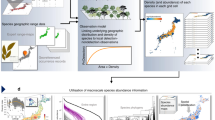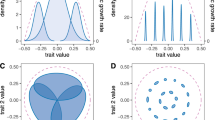Abstract
Ecologists still search for common principles that predict well-known responses of biological diversity to different factors1,2,3,4. Such factors include the number of available niches in space5,6,7, productivity8,9,10, area10, species' body size11,12,13,14 and habitat fragmentation. Here we show that all these patterns can arise from simple constraints on how organisms acquire resources in space. We use spatial scaling laws to describe how species of different sizes find food in patches of varying size and resource concentration. We then derive a mathematical rule for the minimum similarity in size of species that share these resources. This packing rule yields a theory of species diversity that predicts relations between diversity and productivity more effectively thanprevious models8,9,10. Size and diversity patterns for locally coexisting East African grazing mammals and North American savanna plants strongly support these predictions. The theory also predicts relations between diversity and area and between diversity and habitat fragmentation. Thus, spatial scaling laws provide potentially unifying first principles that may explain many important patterns of species diversity.
This is a preview of subscription content, access via your institution
Access options
Subscribe to this journal
Receive 51 print issues and online access
$199.00 per year
only $3.90 per issue
Buy this article
- Purchase on Springer Link
- Instant access to full article PDF
Prices may be subject to local taxes which are calculated during checkout



Similar content being viewed by others
References
Brown, J. H. Two decades of homage to Santa Rosalia: toward a general theory of diversity. Am. Zool. 21, 877–888 (1981).
May, R. M. How many species are there on earth? Science 241, 1441–1449 (1988).
Schluter, D. & Ricklefs, R. (eds) Species Diversity in Ecological Communities: Historical and Geographical Perspectives (Univ. Chicago Press, Chicago, (1994).
Huston, M. A. Biological Diversity: The Coexistence of Species on Changing Landscapes (Cambridge Univ. Press, Cambridge, (1994).
Hutchinson, G. E. Homage to Santa Rosalia, or why are there so many kinds of animals? Am. Nat. 93, 145–159 (1959).
MacArthur, R. H. Environmental factors affecting bird species diversity. Am. Nat. 98, 387–397 (1964).
Morse, D., Stork, N. E. & Lawton, J. H. Fractal dimension of vegetation and the distribution of arthropod body lengths. Nature 314, 731–732 (1985).
Tilman, D. & Pacala, S. W. in Species Diversity in Ecological Communities: Historical and Geographical Perspectives (eds Schluter, D. &Ricklefs, R.) 13–25 (Univ. Chicago Press, Chicago, (1994).
Rosenzeig, M. L. & Abramsky, Z. in Species Diversity in Ecological Communities: Historical and Geographical Perspectives (eds Schluter, D. &Ricklefs, R.) 52–65 (Univ. Chicago Press, Chicago, (1994).
Rosenzweig, M. L. Species Diversity in Space and Time (Cambridge Univ. Press, Cambridge, (1995).
Hutchinson, G. E. & MacArthur, R. H. Atheoretical model of size distributions among species of animals. Am. Nat. 93, 117–125 (1959).
Brown, J. H., Marquet, P. & Taper, M. Evolution of body size: consequences of an energetic definition of fitness. Am. Nat. 142, 573–584 (1993).
Siemann, E., Tilman, D. & Haarstad, J. Insect species diversity, abundance and body size relationships. Nature 380, 704–706 (1996).
Belovsky, G. E. Optimal foraging and community structure: the allometry of herbivore food selection and competition. Evol. Ecol. 11, 641–672 (1997).
Milne, B. T. Spatial aggregation and neutral models in fractal landscapes. Am. Nat. 139, 32–57 (1992).
Milne, B. T. in Wildlife and Landscape Ecology: Effects of Pattern and Scale (ed. Bissonette, J.) 32–69 (Springer, New York, (1997).
Mandelbrot, B. B. The Fractal Geometry of Nature. (Freeman, New York, (1983).
O'Neill, R. V., Milne, B. T., Turner, M. G. & Gardner, R. H. Resource utilization scales and landscape pattern. Land. Ecol. 2, 63–69 (1988).
Ritchie, M. E. Scale-dependent foraging and patch choice in fractal environments. Evol. Ecol. 12, 309–330 (1998).
Schoener, T. W. Population growth regulated by intraspecific competition for energy or time: some simple representations. Theor. Pop. Biol. 6, 265–307 (1973).
Damuth, J. Population density and body size in mammals. Nature 290, 699–700 (1981).
Sinclair, A. R. E. & Norton-Griffiths, M. (eds) Serengeti: Dynamics of an Ecosystem (Univ. Chicago, Chicago, (1979).
Kingdon, J. East African Mammals: an Atlas of Evolution in AfricaVol. 1–7 (Academic, New York, (1979).
Prins, H. H. T. & Olff, H. in Dynamics of Tropical Communities (eds Newbery, D. M., Prins, H. H. T. &Brown, N. D.) 449–490 (Blackwell, Oxford, (1998).
Ritchie, M. E., Tilman, D. & Knops, J. M. H. Effects of herbivores on plant and nitrogen dynamics in oak savanna. Ecology 79, 165–177 (1998).
Grime, J. P. Plant Strategies and Vegetation Processes (Wiley, Chichester, (1979).
Wright, D. H. Species-energy theory: an extension of species-area theory. Oikos 41, 496–506 (1983).
Palmer, M. W. The coexistence of species in fractal landscapes. Am. Nat. 139, 375–397 (1992).
Jones, C. G. & Lawton, J. H. Plant chemistry and insect species richness of British umbellifers. J. Anim. Ecol. 60, 767–777 (1991).
Hubbell, S. P. Aunified theory of biogeography and relative species abundance and its application to tropical rainforests and coral reefs. Coral Reefs 16, S9–S21 (1997).
Acknowledgements
We thank B. Milne, J. H. Brown, H. DeKroon, J. H. Emlen, S. Gripne, A. Guss, N.Haddad, L. Li, S. Naeem and W. Pitt for comments. Supported by the US NSF, The Netherlands NWO, Santa Fe Institute and USU Ecology Center.
Author information
Authors and Affiliations
Corresponding author
Rights and permissions
About this article
Cite this article
Ritchie, M., Olff, H. Spatial scaling laws yield a synthetic theory of biodiversity. Nature 400, 557–560 (1999). https://doi.org/10.1038/23010
Received:
Accepted:
Issue Date:
DOI: https://doi.org/10.1038/23010
This article is cited by
-
Leaf phenotypic variation in natural populations of Carpinus tschonoskii in China
Journal of Forestry Research (2023)
-
Intraspecific trait variability is relevant in assessing differences in functional composition between native and alien aquatic plant communities
Hydrobiologia (2023)
-
Grass and ground dwelling beetle community responses to holistic and wildlife grazing management using a cross-fence comparison in Western Kalahari rangeland, Namibia
Journal of Insect Conservation (2022)
-
Predicting livestock depredation risk by African lions (Panthera leo) in a multi-use area of northern Tanzania
European Journal of Wildlife Research (2020)
-
Collective responses in electrical activities of neurons under field coupling
Scientific Reports (2018)
Comments
By submitting a comment you agree to abide by our Terms and Community Guidelines. If you find something abusive or that does not comply with our terms or guidelines please flag it as inappropriate.



